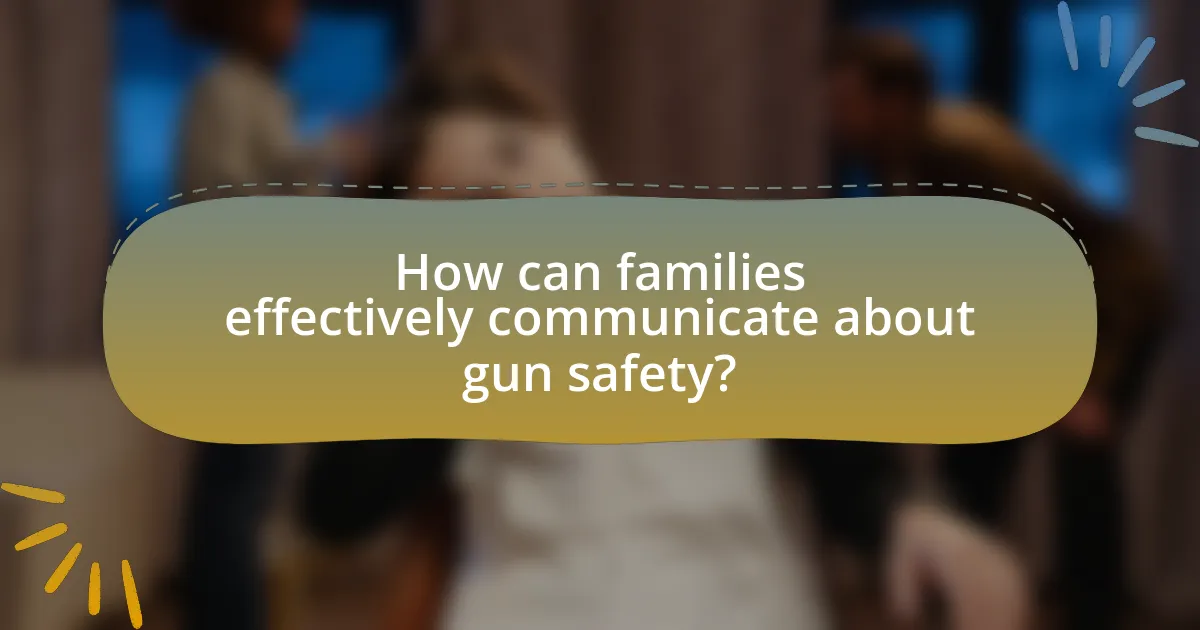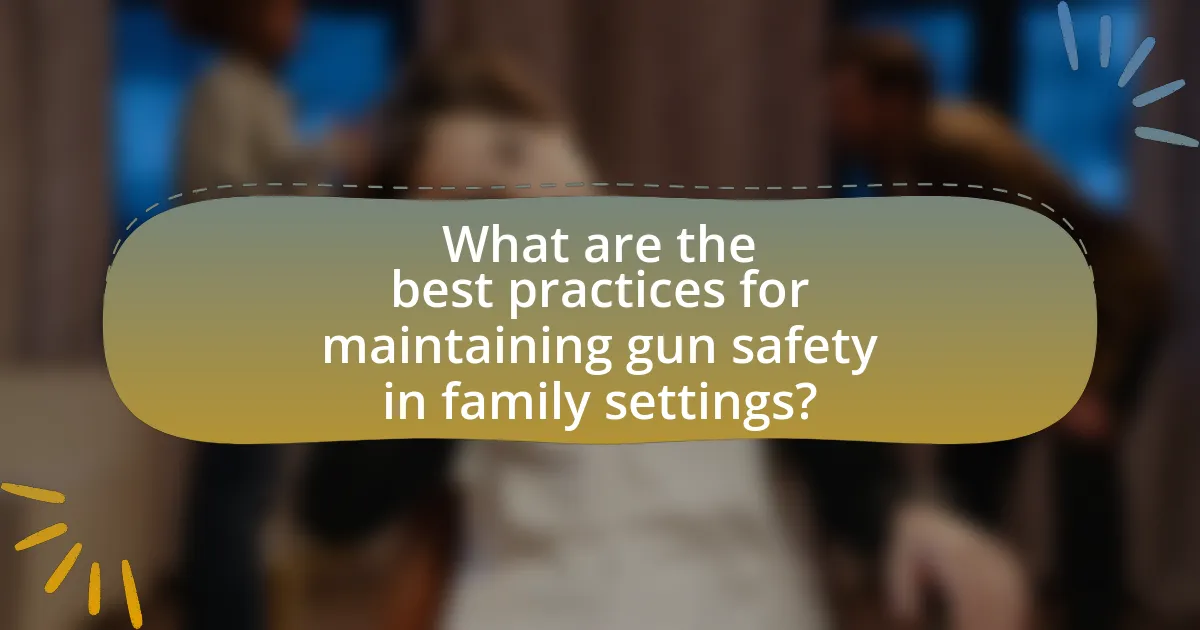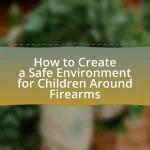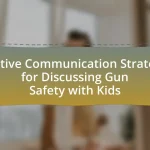The article focuses on the importance of incorporating gun safety into family activities and discussions. It emphasizes the need for open communication about safe handling, storage, and responsibilities associated with firearms to prevent accidents, particularly among children. Key topics include effective strategies for discussing gun safety, the risks of neglecting safety measures, and the role of education in fostering a culture of responsibility. The article also outlines practical tips for families to enhance gun safety awareness, including establishing clear guidelines, utilizing educational resources, and creating a comprehensive gun safety plan.

What does incorporating gun safety into family activities and discussions entail?
Incorporating gun safety into family activities and discussions entails actively engaging family members in conversations about safe handling, storage, and the responsibilities associated with firearms. This includes setting clear rules about when and how to handle guns, emphasizing the importance of keeping firearms locked and out of reach of children, and practicing safe behaviors through role-playing scenarios. Research indicates that families who discuss gun safety regularly are more likely to implement effective safety measures, reducing the risk of accidental shootings. For instance, a study published in the Journal of the American Medical Association found that households with children who had received gun safety education reported fewer incidents of firearm-related injuries.
Why is it important to discuss gun safety within families?
Discussing gun safety within families is crucial for preventing accidents and ensuring responsible firearm ownership. Families that engage in open conversations about gun safety can significantly reduce the risk of unintentional shootings, particularly among children. According to the American Academy of Pediatrics, approximately 1,300 children die from gun-related injuries each year in the United States, highlighting the urgent need for education and awareness. By fostering an environment where gun safety is prioritized, families can instill safe practices and create a culture of responsibility, ultimately leading to safer homes and communities.
What are the potential risks of not addressing gun safety?
Not addressing gun safety poses significant risks, including increased accidental shootings, higher rates of gun-related suicides, and greater potential for firearm theft. Research indicates that in homes without proper gun storage, children are more likely to access firearms, leading to unintentional injuries or fatalities; for instance, the American Academy of Pediatrics reports that nearly 1,300 children die from gun-related injuries each year in the United States. Furthermore, neglecting gun safety can contribute to a culture of irresponsibility around firearms, exacerbating issues of violence and crime. In 2020, the Centers for Disease Control and Prevention noted that firearm homicides reached their highest level in over two decades, highlighting the urgent need for effective gun safety measures.
How can open discussions about gun safety foster a safer environment?
Open discussions about gun safety can foster a safer environment by promoting awareness and understanding of responsible firearm handling among family members. Engaging in these conversations allows families to establish clear guidelines and expectations regarding gun use, which can significantly reduce the risk of accidents. For instance, research from the American Academy of Pediatrics indicates that homes with children and firearms should have secure storage practices and open dialogues about gun safety, leading to a 43% reduction in unintentional firearm injuries among children. By normalizing discussions about gun safety, families can create a culture of responsibility and vigilance, ultimately contributing to a safer community.
What are effective ways to incorporate gun safety into family activities?
Effective ways to incorporate gun safety into family activities include organizing educational sessions, practicing safe handling techniques, and engaging in discussions about responsible gun ownership. Educational sessions can involve inviting a certified firearms instructor to teach family members about gun safety rules, such as the four fundamental rules established by the National Rifle Association: treat every gun as if it is loaded, never point a gun at anything you do not intend to shoot, keep your finger off the trigger until ready to shoot, and be sure of your target and what is beyond it. Practicing safe handling techniques can be done through supervised drills where family members learn to load, unload, and store firearms safely. Engaging in discussions about responsible gun ownership can help reinforce the importance of safety and encourage family members to share their thoughts and concerns, fostering a culture of safety within the household.
How can families use games to teach gun safety principles?
Families can use games to teach gun safety principles by incorporating interactive activities that simulate real-life scenarios involving firearms. For example, families can create role-playing games where participants practice responding to situations involving gun safety, such as identifying safe versus unsafe behaviors around firearms. Research indicates that active participation in learning activities enhances retention of safety principles, making it more likely that children will remember and apply these lessons in real situations. Additionally, board games or card games designed specifically around gun safety can reinforce knowledge through repetition and engagement, further solidifying understanding of critical safety rules.
What role do family outings play in reinforcing gun safety awareness?
Family outings play a crucial role in reinforcing gun safety awareness by providing a practical setting for discussions and demonstrations of safe practices. Engaging in outdoor activities allows families to incorporate lessons about gun safety in a relaxed environment, making it easier for children to absorb important information. Research indicates that hands-on experiences and open conversations during family outings significantly enhance retention of safety protocols, as families can model responsible behavior and address questions in real-time. For instance, a study published in the Journal of Family Psychology found that families who actively discussed safety during recreational activities reported higher levels of awareness and understanding of gun safety among children.
How can families create a culture of safety regarding firearms?
Families can create a culture of safety regarding firearms by establishing open communication about gun safety and implementing strict safety practices. Open discussions about the risks associated with firearms can help children understand the importance of safety, while setting rules such as keeping guns locked and unloaded reinforces responsible behavior. Research indicates that homes with secure storage practices significantly reduce the risk of firearm accidents among children, highlighting the effectiveness of these measures. Additionally, engaging in regular family activities that emphasize safety, such as attending gun safety courses together, can further instill a culture of responsibility and awareness surrounding firearms.
What guidelines should families establish for safe firearm handling?
Families should establish clear guidelines for safe firearm handling, including always treating firearms as if they are loaded, keeping firearms secured and out of reach of children, and ensuring that all family members are educated on firearm safety. These guidelines are essential to prevent accidental discharges and unauthorized access, which are significant contributors to firearm-related injuries and fatalities. According to the National Safety Council, proper education and secure storage can reduce the risk of firearm accidents by up to 85%.
How can families model responsible behavior around firearms?
Families can model responsible behavior around firearms by establishing clear rules about gun safety and actively engaging in discussions about the importance of responsible firearm ownership. For instance, families can implement practices such as securely storing firearms in locked cabinets, ensuring that children do not have access to them, and regularly reviewing safety protocols. Research indicates that households with children who have undergone firearm safety training are less likely to experience accidental shootings, highlighting the effectiveness of education in promoting safe practices. Additionally, families can participate in community programs that focus on gun safety, further reinforcing the importance of responsible behavior around firearms.
What resources are available for families to learn about gun safety?
Families can access various resources to learn about gun safety, including the National Rifle Association’s Eddie Eagle GunSafe Program, which provides educational materials for children. Additionally, the American Academy of Pediatrics offers guidelines and resources for parents on safe firearm storage and handling. The Centers for Disease Control and Prevention also provides information on gun safety and injury prevention. These organizations offer structured programs, literature, and online resources that emphasize the importance of safe practices around firearms, contributing to a safer environment for families.
What educational materials can families utilize to enhance their understanding of gun safety?
Families can utilize a variety of educational materials to enhance their understanding of gun safety, including books, online courses, and instructional videos. For instance, the National Rifle Association (NRA) offers resources such as the “Eddie Eagle GunSafe Program,” which provides age-appropriate materials for children to learn about gun safety. Additionally, organizations like the American Academy of Pediatrics recommend educational pamphlets and guides that outline safe storage practices and the importance of discussing gun safety with children. These materials are designed to provide families with concrete knowledge and practical strategies to promote a safe environment regarding firearms.
How can families find local programs or workshops on gun safety?
Families can find local programs or workshops on gun safety by searching online through resources such as the National Rifle Association (NRA) website, local law enforcement agencies, or community centers that often host safety courses. These platforms typically provide listings of certified training programs and workshops available in specific areas. For example, the NRA offers a “Find a Course” feature that allows users to locate firearm safety classes based on their zip code, ensuring access to relevant and nearby training opportunities.

How can families effectively communicate about gun safety?
Families can effectively communicate about gun safety by establishing open dialogues that prioritize education and understanding. Engaging in regular discussions about the importance of gun safety, including safe storage practices and the potential risks associated with firearms, fosters a culture of safety. Research indicates that families who discuss gun safety openly are more likely to implement safety measures, such as using gun safes and educating children about the dangers of firearms. For instance, a study published in the journal “Pediatrics” found that children who are educated about gun safety are less likely to engage in risky behaviors around firearms.
What strategies can facilitate open conversations about gun safety?
To facilitate open conversations about gun safety, families can implement strategies such as establishing a safe environment for discussion, using age-appropriate language, and incorporating real-life scenarios. Creating a non-judgmental atmosphere encourages family members to express their thoughts and concerns freely. Research indicates that children who engage in discussions about gun safety with their parents are more likely to understand the risks and make safer choices (American Academy of Pediatrics, 2019). Additionally, utilizing resources like educational videos or community workshops can provide context and stimulate dialogue, making the topic more relatable and less intimidating.
How can families approach sensitive topics related to firearms?
Families can approach sensitive topics related to firearms by fostering open communication and creating a safe environment for discussion. Establishing a non-judgmental space encourages family members to express their thoughts and feelings about firearms, which can lead to better understanding and shared values regarding gun safety. Research indicates that families who engage in regular conversations about firearms are more likely to adopt safe practices, as highlighted in studies by the American Academy of Pediatrics, which emphasize the importance of discussing gun safety in the context of overall child safety.
What questions should families ask to encourage dialogue about gun safety?
Families should ask questions such as, “What do you think are the most important rules for handling guns safely?” This question encourages children to express their understanding of gun safety rules, fostering an open dialogue. Additionally, families can ask, “How would you feel if you saw a gun in someone’s home?” This question helps gauge children’s comfort levels and perceptions about guns, promoting discussion about safe environments. Another effective question is, “What should we do if we find a gun?” This inquiry reinforces the importance of knowing the correct actions to take in potentially dangerous situations. Engaging in these discussions can significantly enhance awareness and understanding of gun safety within the family context.
How can families address misconceptions about gun safety?
Families can address misconceptions about gun safety by engaging in open discussions and education about firearms. By creating a safe environment for dialogue, families can clarify myths, such as the belief that guns are inherently safe when stored improperly. Research indicates that homes with children and firearms should implement secure storage practices, as the American Academy of Pediatrics states that proper storage reduces the risk of unintentional shootings by 73%. Additionally, families can participate in gun safety courses together, reinforcing the importance of responsible gun ownership and handling. This proactive approach not only dispels misconceptions but also fosters a culture of safety and responsibility within the household.
What common myths about gun safety should families be aware of?
Common myths about gun safety that families should be aware of include the belief that guns are always unloaded when stored, that children cannot access firearms if they are locked away, and that gun safety training is unnecessary for young children. Research indicates that approximately 1.7 million children live in homes with loaded and unlocked firearms, highlighting the risk of assuming guns are secure. Additionally, studies show that children as young as three can access firearms if they are not stored properly, emphasizing the importance of secure storage methods. Furthermore, the American Academy of Pediatrics recommends that gun safety education should begin early, as children can understand basic safety principles.
How can families correct misinformation regarding firearms?
Families can correct misinformation regarding firearms by engaging in open discussions and providing accurate information based on credible sources. By educating themselves on firearm safety and laws, families can dispel myths and clarify misconceptions. For instance, the National Rifle Association (NRA) and the Centers for Disease Control and Prevention (CDC) offer resources that provide factual data about gun safety practices and statistics. Additionally, families can encourage critical thinking by discussing the differences between facts and opinions, helping members to evaluate the reliability of the information they encounter.
What role does education play in promoting gun safety within families?
Education plays a crucial role in promoting gun safety within families by providing knowledge and skills necessary to handle firearms responsibly. Through structured educational programs, families can learn about safe storage practices, the importance of keeping firearms away from children, and how to respond in emergencies involving guns. Research indicates that families who engage in gun safety education are significantly more likely to implement safety measures, such as using gun safes and educating children about the dangers of firearms. For instance, a study published in the journal “Pediatrics” found that children who received gun safety education were less likely to engage in risky behaviors around firearms. This evidence underscores the effectiveness of education in fostering a culture of safety and responsibility regarding gun ownership within families.
How can families incorporate gun safety education into daily routines?
Families can incorporate gun safety education into daily routines by integrating discussions about gun safety into everyday conversations and activities. For instance, families can establish specific times, such as during meals or family meetings, to talk about the importance of gun safety, including safe storage practices and the significance of treating all guns as if they are loaded. Additionally, families can use teachable moments, such as watching news stories or movies that involve firearms, to discuss the implications of gun use and safety. Research indicates that consistent conversations about safety can significantly reduce the risk of accidental shootings, as families who engage in regular discussions about gun safety are more likely to implement effective safety measures at home.
What age-appropriate resources are available for teaching children about gun safety?
Age-appropriate resources for teaching children about gun safety include educational programs, books, and interactive materials designed for various age groups. The National Rifle Association (NRA) offers the “Eddie Eagle GunSafe® Program,” which targets preschool and elementary-aged children, teaching them to recognize the dangers of guns and to seek help from an adult if they encounter one. Additionally, the “Smart Start” program by the National Shooting Sports Foundation provides resources for parents to discuss gun safety with young children. Books such as “My Parents Are Divorced, My Elbows Have Wings” by Phyllis Naylor and “The Berenstain Bears: Guns” by Stan and Jan Berenstain also serve as effective tools for introducing gun safety concepts in a relatable manner. These resources are validated by organizations focused on child safety and education, ensuring they are suitable for young audiences.

What are the best practices for maintaining gun safety in family settings?
The best practices for maintaining gun safety in family settings include securely storing firearms, educating family members about gun safety, and establishing clear rules regarding gun access. Secure storage involves using gun safes or lockboxes to prevent unauthorized access, particularly by children. Education should encompass discussions about the dangers of firearms, safe handling practices, and the importance of never pointing a gun at anyone. Establishing rules means setting clear guidelines about when and how firearms can be accessed, ensuring that all family members understand and respect these rules. According to the National Safety Council, proper storage and education can significantly reduce the risk of accidental shootings in homes with firearms.
How can families ensure firearms are stored safely at home?
Families can ensure firearms are stored safely at home by using secure storage methods such as gun safes or lockboxes. These storage solutions prevent unauthorized access, particularly by children, and are recommended by organizations like the National Shooting Sports Foundation, which states that safe storage can significantly reduce the risk of firearm-related accidents. Additionally, families should regularly review and practice safe storage protocols, ensuring that all members understand the importance of keeping firearms locked and out of reach.
What types of gun safes are recommended for family use?
For family use, biometric gun safes and quick-access safes are recommended. Biometric gun safes utilize fingerprint recognition technology, allowing for rapid access while ensuring that only authorized users can open them, which enhances safety in a household with children. Quick-access safes, often equipped with keypad or mechanical locks, provide immediate access to firearms in emergencies while maintaining secure storage. According to the National Shooting Sports Foundation, these types of safes are effective in preventing unauthorized access and promoting responsible firearm storage practices in family environments.
How can families implement regular safety checks for firearms?
Families can implement regular safety checks for firearms by establishing a routine schedule for inspections and involving all responsible members in the process. This can include checking the firearm’s condition, ensuring it is stored securely, and verifying that ammunition is stored separately. According to the National Shooting Sports Foundation, regular checks can significantly reduce the risk of accidental discharges and unauthorized access, emphasizing the importance of consistent safety practices in households with firearms.
What should families do in case of a gun-related incident?
In case of a gun-related incident, families should immediately seek safety by finding a secure location away from the threat. This action is crucial as it minimizes the risk of harm to family members. Following this, families should contact emergency services to report the incident, ensuring that trained professionals can respond appropriately. According to the National Safety Council, having a clear plan and practicing it can significantly reduce panic and confusion during such emergencies, highlighting the importance of preparedness in family discussions about gun safety.
How can families prepare for emergencies involving firearms?
Families can prepare for emergencies involving firearms by establishing clear safety protocols and ensuring all members are educated on firearm handling. This includes securing firearms in locked storage, using gun safes, and keeping ammunition separate from firearms to prevent unauthorized access. According to the National Safety Council, safe storage practices can significantly reduce the risk of accidental shootings, particularly among children. Additionally, families should conduct regular discussions about firearm safety, emphasizing the importance of treating every firearm as if it is loaded and the necessity of reporting any unsafe situations. Engaging in role-playing scenarios can also help family members respond appropriately in emergencies.
What steps should families take immediately following a gun-related incident?
Families should prioritize safety and communication immediately following a gun-related incident. First, they must ensure that everyone is safe and remove any immediate threats by securing the firearm and calling emergency services if necessary. Next, families should discuss the incident openly, allowing each member to express their feelings and concerns, which can help in processing the event. It is also crucial to seek professional help, such as counseling, to address any trauma experienced. According to the American Psychological Association, open communication and professional support can significantly aid in recovery after traumatic events.
What practical tips can families follow to enhance gun safety awareness?
Families can enhance gun safety awareness by implementing clear communication about firearms, establishing rules for safe handling, and engaging in regular safety discussions. Open dialogue ensures that all family members understand the importance of gun safety and the potential risks involved. Establishing specific rules, such as keeping firearms locked and unloaded when not in use, reinforces safe practices. Regular discussions about gun safety, including role-playing scenarios and reviewing safety protocols, help to keep the topic relevant and top-of-mind. According to the National Safety Council, educating family members about the dangers of firearms and promoting safe behaviors can significantly reduce the risk of accidental shootings.
How can families create a gun safety plan together?
Families can create a gun safety plan together by engaging in open discussions about firearm safety, establishing rules for safe storage, and practicing emergency procedures. Open discussions should include all family members, emphasizing the importance of safety and addressing any questions or concerns. Establishing rules for safe storage involves deciding on secure locations for firearms, such as locked cabinets or safes, and ensuring that ammunition is stored separately. Practicing emergency procedures can include role-playing scenarios where family members respond to potential situations involving firearms, reinforcing the importance of safety protocols. These steps are supported by research indicating that families who actively engage in safety discussions and practices significantly reduce the risk of firearm-related accidents.
What ongoing practices can families adopt to keep gun safety a priority?
Families can adopt ongoing practices such as regular discussions about gun safety, secure storage of firearms, and participation in safety training programs to prioritize gun safety. Engaging in open conversations about the importance of gun safety helps reinforce awareness among family members, particularly children. Secure storage, including the use of gun safes or lockboxes, prevents unauthorized access and reduces the risk of accidents. Additionally, enrolling in safety training programs, such as those offered by the National Rifle Association or local law enforcement, equips families with essential knowledge and skills to handle firearms responsibly. These practices collectively contribute to a culture of safety and responsibility regarding firearms within the household.


